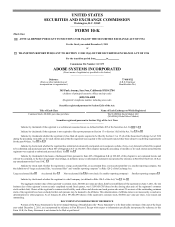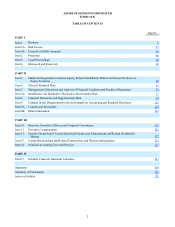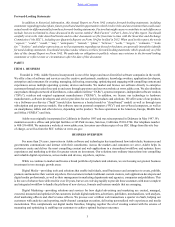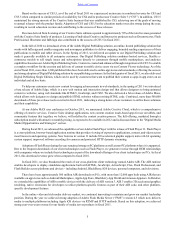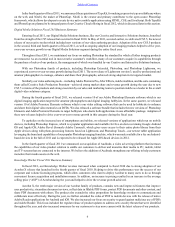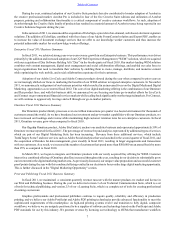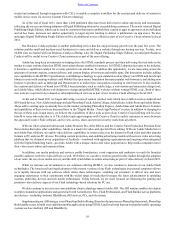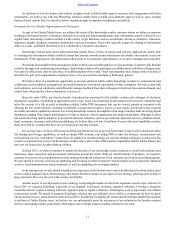Adobe 2011 Annual Report Download - page 11
Download and view the complete annual report
Please find page 11 of the 2011 Adobe annual report below. You can navigate through the pages in the report by either clicking on the pages listed below, or by using the keyword search tool below to find specific information within the annual report.
11
As millions of web developers and website designers look to build mobile apps to increase their engagement with their
constituents, we believe our AIR and PhoneGap solutions enable them to build cross-platform apps as well as reuse existing
browser-based content they've created to deliver standalone apps on popular smartphones and tablets.
Document Services Market Opportunities and Strategies
As part of our Digital Media focus, we address the needs of the knowledge worker customer whom we define as someone
working in document intensive industries, focused on creating and disseminating high-value information as part of their job on a
regular basis. Knowledge workers include a wide variety of job functions such as accountants, attorneys, architects, educators,
engineers, graphic designers, insurance underwriters and stock analysts. These jobs typically require the sharing of information
either as a static, published document or as a collaborative, interactive document.
Knowledge workers must create information and content from a variety of sources and software applications, and be able
to exchange this information within a reliable format that ensures coworkers and constituents can reliably and securely access the
information. When appropriate, this information often needs to be protected, authenticated, or securely managed and controlled.
Document-based collaboration among knowledge workers can occur through face-to-face meetings, via phone calls, through
e-mail or through web conferencing technologies. Knowledge workers who participate in collaborations with their colleagues may
be located in offices next door to each other, or in different parts of the world. These team members may change with every project
and either be part of an organization's employee base, or be an external consultant or third-party partner.
We believe there is a significant opportunity to provide solutions which enable knowledge workers to communicate and
collaborate across technical, geographical and social boundaries, both inside and outside of their companies. We believe that with
such solutions, users can collaborate and efficiently manage feedback from their colleagues in both real time and on-demand, and
control how, when and by whom information is accessed.
Since the early 1990s, our Acrobat family of products has provided for the reliable creation and exchange of electronic
documents, regardless of platform or application source type. Users can collaborate on documents with electronic comments and
tailor the security of a file in order to distribute reliable Adobe PDF documents that can be viewed, printed or interacted with
utilizing the free Adobe Reader. Available in different versions which target a variety of user needs, Acrobat provides essential
electronic document capabilities and services to help knowledge workers accomplish a wide range of ad hoc tasks involving digital
documents ranging from simple publications to forms to mission critical engineering and architectural plans. Although Acrobat
has achieved strong market adoption in document-intensive industries such as government, financial services, pharmaceutical,
legal, aerospace, insurance and technical publishing, we believe there are tens of millions of users who need capabilities such as
those provided by Acrobat who have not yet licensed an Acrobat solution.
For several years, we have offered our Acrobat.com hosted service to provide knowledge workers with centralized online
file sharing and storage capabilities, as well as simple PDF creation, converting PDF to other file formats, and personal web
conferencing services with Adobe ConnectNow. In addition to complementing our Acrobat desktop solutions, Acrobat.com has
served as an introductory service for knowledge workers who wish to utilize PDF-creation capabilities and the Adobe Reader, but
have not yet licensed an Acrobat desktop solution.
In fiscal 2012, we plan to continue to market the benefits of our knowledge worker solutions to small-and medium-sized
businesses, large enterprises and government institutions around the world. With our Acrobat family of products, we intend to
continue to increase our seat penetration in these markets through the utilization of our corporate and volume licensing programs.
We also intend to increase our focus on marketing and licensing Acrobat in targeted vertical markets such as education, financial
services, telecommunications and government, as well as expanding into emerging markets.
In the coming year, we also intend to build on our experience with Acrobat.com to provide additional cloud-based document
services which augment our Acrobat strategy. Our Adobe SendNow feature is one aspect of our strategy, allowing users to deliver
large electronic files over the web with security and fidelity.
Another aspect of our document services strategy is targeting the market of electronic signatures used to sign contracts. In
fiscal 2011 we acquired EchoSign, a provider of on-demand, web-based, electronic signature solutions. Utilizing a simplistic
model that doesn't require scanning software, signature pads or digital certificates, EchoSign is used to sign nearly one million
contracts per month. We intend to integrate EchoSign's solution into our offerings, and it will be a cornerstone for how we grow
our document services, cloud-based revenue in fiscal 2012. In addition, by making the cloud-based EchoSign capabilities available
to millions of Adobe Reader users, we believe we can substantially grow the awareness of our solution in the broader contract
delivery and signing market particularly where paper and overnight express mailing continues to be used.
Table of Contents

